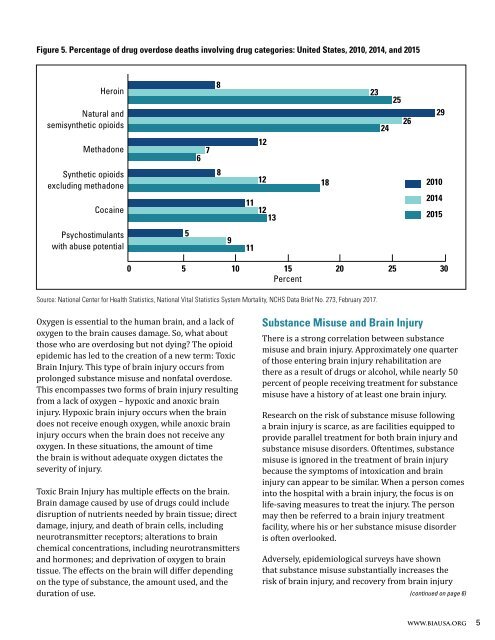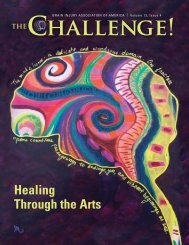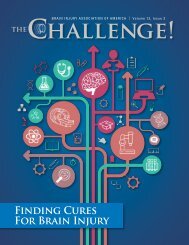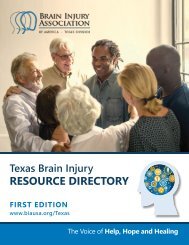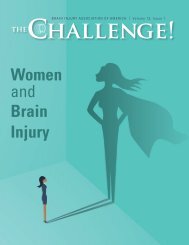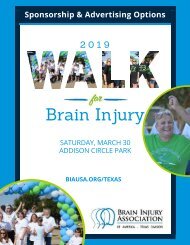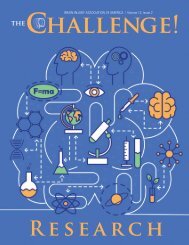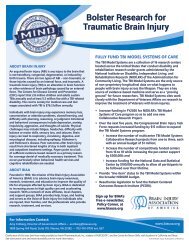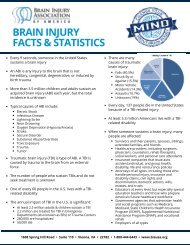THE Challenge! Non-Traumatic Brain Injury
Create successful ePaper yourself
Turn your PDF publications into a flip-book with our unique Google optimized e-Paper software.
Figure 5. Percentage of drug overdose deaths involving drug categories: United States, 2010, 2014, and 2015<br />
Heroin<br />
Natural and<br />
semisynthetic opioids<br />
Methadone<br />
6<br />
7<br />
8<br />
12<br />
23<br />
24<br />
25<br />
26<br />
29<br />
Synthetic opioids<br />
excluding methadone<br />
Cocaine<br />
8<br />
12<br />
11<br />
12<br />
13<br />
18<br />
2010<br />
2014<br />
2015<br />
Psychostimulants<br />
with abuse potential<br />
5<br />
9<br />
11<br />
0 5 10 15 20 25 30<br />
Percent<br />
Source: National Center for Health Statistics, National Vital Statistics System Mortality, NCHS Data Brief No. 273, February 2017.<br />
Oxygen is essential to the human brain, and a lack of<br />
oxygen to the brain causes damage. So, what about<br />
those who are overdosing but not dying? The opioid<br />
epidemic has led to the creation of a new term: Toxic<br />
<strong>Brain</strong> <strong>Injury</strong>. This type of brain injury occurs from<br />
prolonged substance misuse and nonfatal overdose.<br />
This encompasses two forms of brain injury resulting<br />
from a lack of oxygen – hypoxic and anoxic brain<br />
injury. Hypoxic brain injury occurs when the brain<br />
does not receive enough oxygen, while anoxic brain<br />
injury occurs when the brain does not receive any<br />
oxygen. In these situations, the amount of time<br />
the brain is without adequate oxygen dictates the<br />
severity of injury.<br />
Toxic <strong>Brain</strong> <strong>Injury</strong> has multiple effects on the brain.<br />
<strong>Brain</strong> damage caused by use of drugs could include<br />
disruption of nutrients needed by brain tissue; direct<br />
damage, injury, and death of brain cells, including<br />
neurotransmitter receptors; alterations to brain<br />
chemical concentrations, including neurotransmitters<br />
and hormones; and deprivation of oxygen to brain<br />
tissue. The effects on the brain will differ depending<br />
on the type of substance, the amount used, and the<br />
duration of use.<br />
Substance Misuse and <strong>Brain</strong> <strong>Injury</strong><br />
There is a strong correlation between substance<br />
misuse and brain injury. Approximately one quarter<br />
of those entering brain injury rehabilitation are<br />
there as a result of drugs or alcohol, while nearly 50<br />
percent of people receiving treatment for substance<br />
misuse have a history of at least one brain injury.<br />
Research on the risk of substance misuse following<br />
a brain injury is scarce, as are facilities equipped to<br />
provide parallel treatment for both brain injury and<br />
substance misuse disorders. Oftentimes, substance<br />
misuse is ignored in the treatment of brain injury<br />
because the symptoms of intoxication and brain<br />
injury can appear to be similar. When a person comes<br />
into the hospital with a brain injury, the focus is on<br />
life-saving measures to treat the injury. The person<br />
may then be referred to a brain injury treatment<br />
facility, where his or her substance misuse disorder<br />
is often overlooked.<br />
Adversely, epidemiological surveys have shown<br />
that substance misuse substantially increases the<br />
risk of brain injury, and recovery from brain injury<br />
(continued on page 6)<br />
www.biausa.org 5


